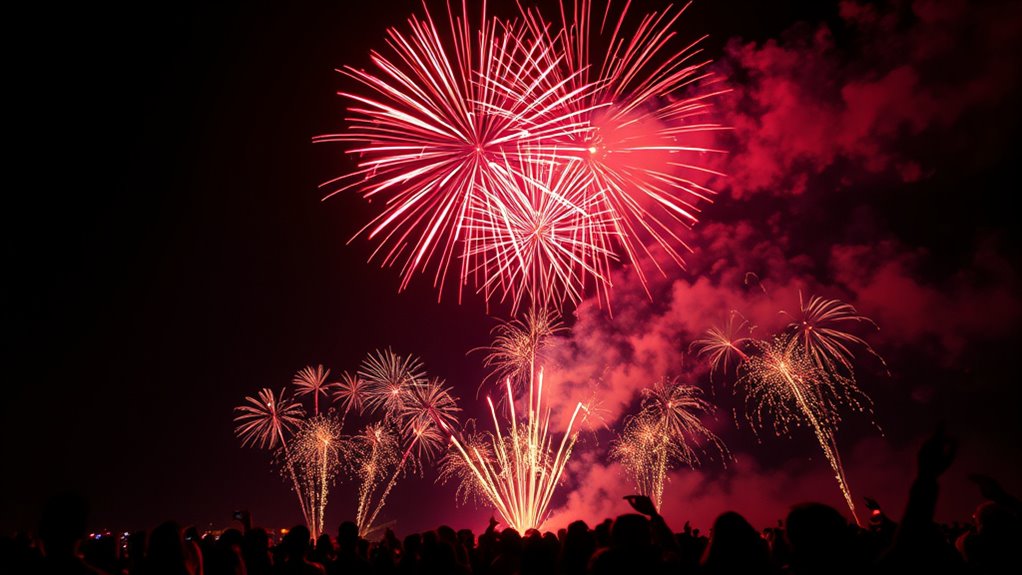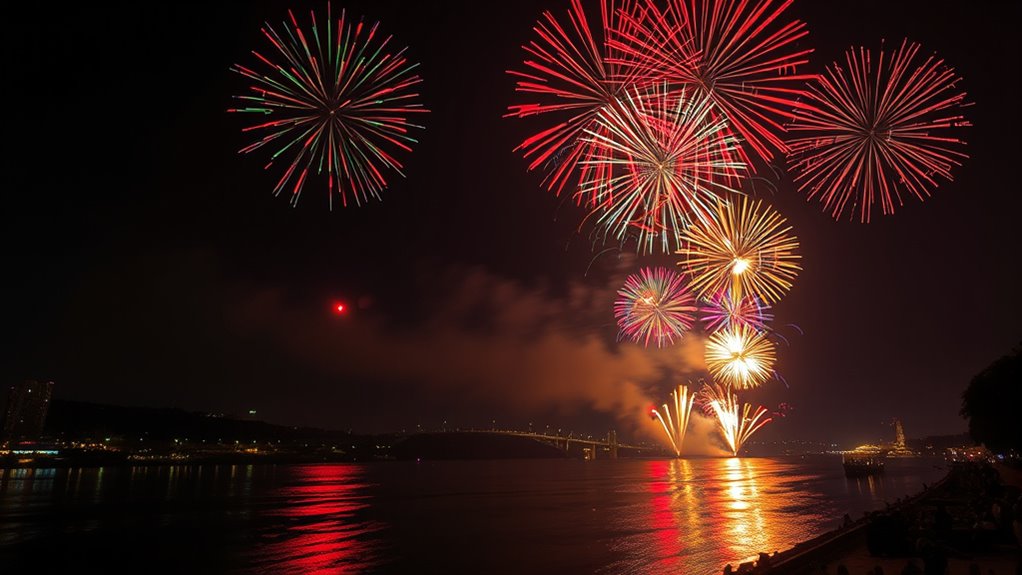Fireworks have a rich history, originating in ancient China where they produced sparks to ward off evil and celebrate harvests. As they spread across Asia and later Europe, these light displays became symbols of prosperity, power, and joy, evolving with improved techniques and technology. Today, fireworks create dazzling spectacles that unite cultures worldwide in moments of awe and celebration. If you keep exploring, you’ll uncover even more fascinating stories behind these vibrant displays of human creativity.
Key Takeaways
- Fireworks originated in ancient China, initially serving practical purposes before evolving into symbols of celebration and prosperity.
- They spread to Europe via traders, where techniques advanced, creating more vibrant colors and complex displays.
- Fireworks have long been integral to cultural traditions, representing good luck, power, and communal unity across Asia and Europe.
- Modern fireworks utilize advanced technology for safer, more elaborate displays, celebrating events like New Year’s and national holidays worldwide.
- The visual spectacle of fireworks reflects humanity’s fascination with light and color, symbolizing hope, joy, and shared human experiences.

Have you ever wondered how light celebrations began? The history of fireworks and light displays is a fascinating journey that stretches back centuries, blending innovation with cultural traditions. The firework evolution started in ancient China, where early inventors discovered that mixing certain chemicals produced bright, colorful sparks. These early pyrotechnic devices initially served practical purposes, like frightening away evil spirits or celebrating successful harvests. Over time, their role shifted from mere functional tools to symbols of joy and festivity. As they spread across Asia, fireworks became deeply embedded in cultural significance, representing prosperity, good fortune, and communal unity. They were used during important festivals, royal celebrations, and religious ceremonies, becoming an integral part of cultural identity. When traders and explorers brought fireworks to Europe in the Middle Ages, their popularity soared. Europeans refined the techniques and materials, creating more sophisticated displays with larger bursts, vibrant colors, and intricate patterns. This firework evolution led to spectacular shows that were often associated with royal courts and public festivities, symbolizing power and celebration. The cultural significance of fireworks grew in tandem with their visual spectacle. They became symbols of triumph, marking victories in battles or the coronation of monarchs. Fireworks also played a role in religious observances, emphasizing divine power and spiritual renewal through mesmerizing displays. As technology advanced, so did the complexity and safety of fireworks, enabling larger, more elaborate displays that captivated audiences worldwide. Today, fireworks continue to be a universal language of celebration, lighting up the night sky during New Year’s Eve, national holidays, and major events. Their evolution from simple chemical reactions to mesmerizing spectacles reflects humanity’s enduring fascination with light and color. The development of specialized fireworks and modern safety standards has allowed for even more elaborate and breathtaking displays, further enriching cultural celebrations around the globe. The cultural significance of fireworks remains strong, connecting generations through shared moments of awe and excitement. Whether used to honor tradition or to mark new beginnings, fireworks symbolize hope, unity, and the human desire to create beauty from darkness. From their humble beginnings in ancient China to their modern, global celebrations, the firework evolution underscores a universal truth: light has an extraordinary power to bring people together, evoke emotion, and mark significant milestones. As you watch a dazzling display light up the sky, remember that this spectacular art form carries a rich history woven into the fabric of countless cultures, celebrating life’s most memorable moments with every burst of color.
Frequently Asked Questions
How Do Fireworks Affect Local Wildlife and Ecosystems?
Fireworks can profoundly impact local wildlife and ecosystems. You might notice wildlife disruption as animals become startled and hide or flee from the noise and bright flashes. This can lead to ecosystem disturbance, especially when multiple events occur. Your fireworks use can unintentionally harm animals, disturb their habitats, and disrupt natural behaviors. To minimize impact, consider quieter, eco-friendly options or schedule celebrations away from sensitive wildlife areas.
What Are the Safety Innovations in Modern Fireworks?
Modern fireworks feature advanced pyrotechnic safety measures and improved ignition technology, making displays safer for both operators and spectators. These innovations include electronic ignition systems that reduce accidental ignitions and safer handling procedures. Fireworks manufacturers also use safer chemical formulations to minimize risks. By adopting these technologies, you can enjoy spectacular shows while ensuring safety is prioritized, reducing accidents and environmental impact.
How Do Different Cultures Incorporate Light Shows in Their Festivals?
You’re captivated by how cultures weave light shows into their festivals, revealing deep cultural symbolism and traditional practices. In Japan, lantern festivals illuminate the night to honor ancestors, while India’s Diwali sparkles with diyas symbolizing victory of light over darkness. In China, dragon dances combined with fireworks celebrate heritage and prosperity. These vibrant displays serve more than spectacle—they embody cultural identity, connecting generations through luminous expressions of tradition.
What Are the Environmental Impacts of Fireworks Production?
You should know that fireworks production impacts the environment through chemical pollution and resource depletion. The chemicals used release harmful toxins into the air, water, and soil, affecting ecosystems and human health. Additionally, extracting raw materials like metals and chemicals depletes natural resources, contributing to environmental degradation. These effects highlight the need for greener alternatives and more sustainable practices in fireworks manufacturing to reduce their ecological footprint.
How Is Technology Advancing the Customization of Fireworks Displays?
Imagine your ideal fireworks display coming alive like a painter’s palette—technology makes this possible through digital customization. You can now design intricate patterns and colors tailored to your event. Drone choreography enhances this experience by creating synchronized aerial displays that dance across the sky. These innovations give you the power to craft spectacular shows that are more personalized, immersive, and breathtaking than ever before, turning dreams into dazzling reality.
Conclusion
Now that you’ve uncovered the dazzling history of fireworks and spectra, you realize these light shows aren’t just events—they’re bursts of human brilliance and creativity that illuminate our darkest nights. Every spark and color represents centuries of innovation and celebration, connecting you to a tradition more vibrant than the stars themselves. Remember, no matter how many times you watch a firework display, it’ll never match the awe-inspiring magic of its first explosive revelation—it’s truly a moment of wonder.








